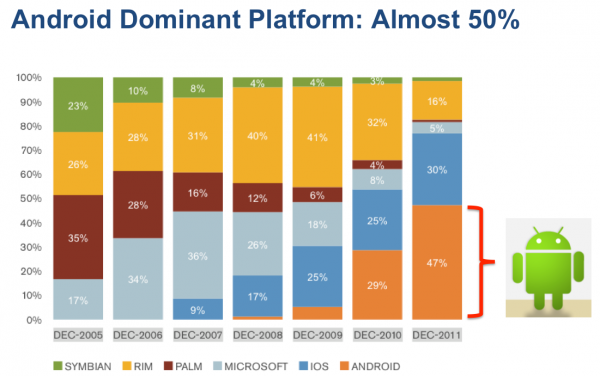Google’s Smartphone Dominance, Tablet Weakness And Surprising Mobile Ad Numbers
In the event you weren’t aware the mobile trade show Mobile World Congress is happening in Barcelona, Spain this week. I’d probably be attending but for SMX West starting tomorrow in San Jose, California. The European show is mostly about hardware, carriers and devices, a larger version of CTIA here in the US. Yesterday there […]
 In the event you weren’t aware the mobile trade show Mobile World Congress is happening in Barcelona, Spain this week. I’d probably be attending but for SMX West starting tomorrow in San Jose, California. The European show is mostly about hardware, carriers and devices, a larger version of CTIA here in the US.
In the event you weren’t aware the mobile trade show Mobile World Congress is happening in Barcelona, Spain this week. I’d probably be attending but for SMX West starting tomorrow in San Jose, California. The European show is mostly about hardware, carriers and devices, a larger version of CTIA here in the US.
Yesterday there was a ton of new device news out. HTC, Sony, LG and Huawei released new tablets and handsets. Without exception those devices are powered by Android.
Android Handset Growth: 300 Million Served
Earlier this morning Google released some new (and impressive) Android activation numbers and related figures. Here they are:
- Total Android devices in market globally: 300 million
- Daily activations: 850,000
- Android apps: 450,000
- Android tablets: 12 million (more on this in a moment)
These numbers are comparable to Apple‘s and soon will surpass them. Apple said earlier this year that there were 315 million iOS devices in the market, with 550,000 apps (170,000 of which are for iPad). In terms of tablet sales Apple has sold 55 million iPads to date.
World Smartphone Domination
Android is unquestionably the world’s leading smartphone operating system, with almost 50 percent market share in the US (as of Q4 2011). The numbers are comparable in other parts of the world. Right now it’s a two-OS race between Apple and Google.
Indeed, Apple is the only thing standing between Google and world smartphone domination.

Source: comScore (2/11)
As android sales go so go Google’s fortunes in mobile. Google controls 95 percent of the browser-based mobile search volume in the US and the numbers are slightly larger on a global basis. But it also dominates mobile display advertising globally as well.
A couple of weeks ago Bytemobile, which helps carriers manage their data and traffic loads, released a report with the following (remarkable) statement in it:
Google is the dominant source of mobile data traffic generated by advertisements. DoubleClick, AdMob and AdSense . . . generate an average of 75% of the total data produced by advertisements.
I was surprised by the 75 percent figure and went back and forth with the company in email a few times to clarify what “75 percent of the total data produced by advertisements” meant exactly. Here’s the exchange:
Me: Does this mean that 75% of the impressions are coming from Google ad servers/networks?
Bytemobile: This means that 75% of the ad data volume, and 75% of the ad traction volume is coming from Google Ad servers/networks (AdSense, AdMob and DoubleClick).
Me: But does it mean that 75% of the ads being served (and this is global?) are Google network ads?
Bytemobile: Yes, for mobile advertisements and to confirm this is global.
Bytemobile is saying then that Google serves/delivers 75 percent of all mobile display ads on a global basis. This is an astounding thing if accurate.
Android Tablet Weakness
The one area where Android is lagging is on the tablet front. Google mobile boss Andy Rubin said that there were 12 million Android tablets nestled among the 300 million active Android devices. I frankly don’t believe there are 12 million Android tablets being used by consumers in the market today. Nowhere in my travels do I see people actually using Android tablets (other than Kindle).
The most popular Android tablet devices are the Kindle Fire and Barnes and Noble Nook. Those two probably constitute half of the 12 million number.
Given the threat that Amazon would actually control the Android tablet market Google has said (though not formally) it will develop its own branded tablet, which will probably be in the 7-inch category. It has also suggested that tablet will be very aggressively priced at parity or below the Kindle Fire’s $199.
The major failing of Android tablets is the lack of tablet-centric apps, which the latest Android version (Ice Cream Sandwich) is supposed to solve. The other problem is that the overall hardware-software quality of Android tablets has been considerably weaker than Apple’s iPad. Ten-inch Android tablets priced comparably to the iPad have failed to sell accordingly.
Amazon’s subsidy pricing of Kindle Fire created huge demand and helped drive more than 4 million sales in Q4.
Contributing authors are invited to create content for MarTech and are chosen for their expertise and contribution to the martech community. Our contributors work under the oversight of the editorial staff and contributions are checked for quality and relevance to our readers. MarTech is owned by Semrush. Contributor was not asked to make any direct or indirect mentions of Semrush. The opinions they express are their own.
Related stories
New on MarTech